Last Updated on June 13, 2025 by Kittredge Cherry
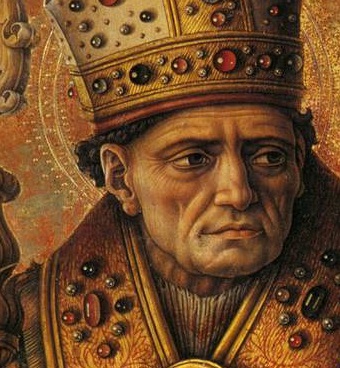
After a sexually active and probably bisexual youth, Augustine of Hippo became an influential early Christian theologian who was sex-negative but argued that God created intersex people. This contradictory queer saint’s feast day is Aug. 28 in western Christianity.
[Update: On May 8, 2025 Pope Leo XIV became the first Pope from the Augustinians, a religious order named for the African saint Augustine of Hippo. Later that day genealogists discovered that his grandparents were people of color (Creole, mulatto and/or black) who assumed a white identity and passed as white when they moved from New Orleans to Chicago. The Pope’s brother said his family never discussed their family’s racial history and they identified completely as white. And yet Leo chose to join the Augustinians. It remains to be seen whether the new Pope will be as open to gender diversity as Augustine was in the 5th century. Protestant reformer Martin Luther was also a member of the Augustinian order — until he was excommunicated in 1520 for his radical writings.]
LGBTQ people may appreciate Augustine’s passionate friendship with another man and his relatively compassionate recognition of gender diversity. Augustine is also often blamed for the misogynist, anti-sex attitude that runs through much of church history. His life and work show that Christians have wrestled with questions of sexuality and gender identity since antiquity.
Augustine is one of the most important Christian thinkers, perhaps second only to Saint Paul of Tarsus. Both are famous converts with a possible same-sex attraction and a sex-negative Christian theology adapted from a classical education.
From 396 to 430 Augustine served as bishop in the North African city of Hippo in present-day Algeria. He also organized a community of men who lived together there like monks and inspired the foundation of a monastic religious order.
Augustine called himself “a slave to lust”
 Augustine’s best-known book is “Confessions,” a vivid tell-all memoir that has fascinated and perhaps titillated readers for centuries. Completed in the year 400, “Confessions” is considered the first Western autobiography. This honest account describes his religious development, emotional life and sexual history as a self-proclaimed “slave to lust.”
Augustine’s best-known book is “Confessions,” a vivid tell-all memoir that has fascinated and perhaps titillated readers for centuries. Completed in the year 400, “Confessions” is considered the first Western autobiography. This honest account describes his religious development, emotional life and sexual history as a self-proclaimed “slave to lust.”
In addition to the section about his possible male lover, he writes at length of illicit affairs with women and fathering a child with his live-in concubine. It was during this sexually active period that he uttered the humorously human prayer that has become famous, living on as a slogan on mugs, T-shirts and such: “God, give me chastity and moderation — but not yet.”
Augustine’s antagonism toward sex is legendary. He was among the first to claim that Sodom was destroyed for the sin of homosexuality. Earlier understandings, even within the Bible itself, identified the sin of Sodom as abusing strangers. He condemned “sodomy” and his own “past foulnesses and carnal corruptions.” But he was less extreme than some of his contemporaries because Augustine conceded that there was some acceptable sex (for procreation within marriage).
His own preference showed when he wondered why God even created women. “How much more agreeable for companionship in a life shared together would be two male friends rather than a man and a woman,” he wrote in “De Genesi ad litteram” (The Literal Meaning of Genesis).
He encouraged intimacy between men in his advice on how to do the kiss of peace after the Eucharist: “When your lips draw near to those of your brother, do not let your heart withdraw from his,” he wrote.
Augustine was born and raised in Africa
Augustine grew up in Roman culture where homosexuality was accepted as normal. Aurelius Augustinus, known as Augustine, (Nov. 13, 354 – Aug. 28, 430) was born in the Roman city of Thagaste in Algeria to a Romanized family with Berber (Amazigh) heritage. No record of his appearance exists, but because he was African there is reason to believe he had dark skin. He has been portrayed as black at various times and places throughout art history and in contemporary works by artists such as John Nava and Bruce Herman.
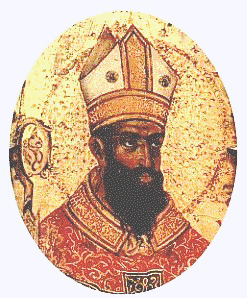
Saint Augustine, artist unknown
His father, Patricius, was a pagan landowner with Roman roots and his mother, Monica, was a pious Christian who was canonized later as a Catholic saint. Monica has been proposed as a patron saint for parents of LGBTQ people.
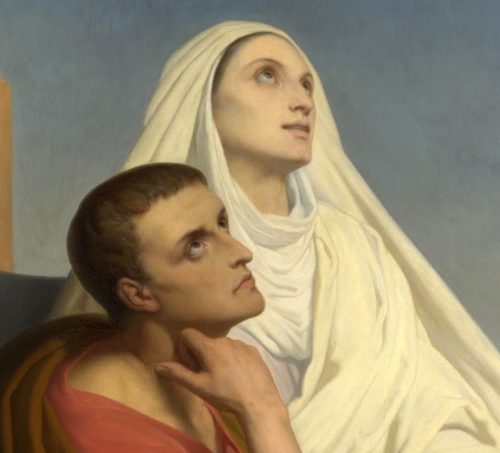
Augustine appears with his mother Monica before they were saints in an 1846 painting by Ary Scheffer (Wikipedia)
A brilliant student, he received a classical Latin education and then became a rhetoric professor. Like most men in his culture, he had a stronger emotional connection to other men than to women, except his mother.
“Although it is debatable to what extent, if any, these passionate friendships were homoerotic, they express a sensibility that today is probably to be found, at least in Western industrial societies, only among gay men,” wrote Toronto historian Brad Walton in “Gay and Lesbian Literary Heritage.”
Augustine and the man he loved
Many see self-incriminating proof of Augustine’s homosexual affairs in his own statements about his youth in Book 3.1 (translated by Carolinne White):
“To love and also be loved in return was what excited me, especially if I could enjoy my lover’s body. So I polluted the stream of friendship with the filth of lust and obscured its brightness with foul passions. But despite this shameful and degrading behavior, in my excessive vanity I hoped to be regarded as elegant and civilized.”
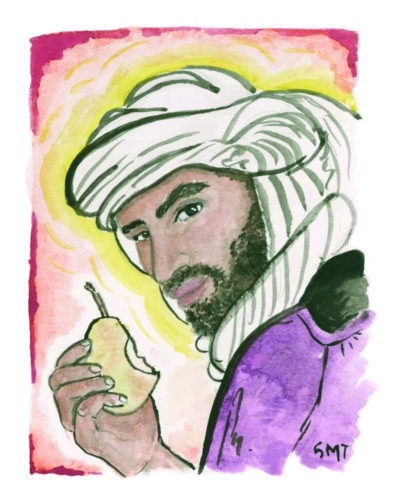
“Saint Augustine of Hippo: Lord, Make Me Pure, But Not Yet” by Sarah Talbot (available on Etsy)
One same-sex relationship stands out in particular. As he wrote in “Confessions,” Augustine fell completely in love with an unnamed young man when they were both in their late teens. His beloved was a fellow student who had grown up with him. This “most dear friend” was “sweet to me above all sweetness… I felt that my soul and his soul were ‘one soul in two bodies,’ ” Augustine wrote. Many have interpreted their relationship as homosexual.
But the friend developed a fever and died. Augustine was devastated by grief, which he described in dramatic terms that echo across the ages. Here is just part of his lengthy description of his turmoil:
“When my friend died, grief darkened my heart and wherever I looked, all I could see was death. My home town was a torture to me and my family home a place of misery. All that I had shared with my friend became excruciating without him. I hated everything because he was absent; nowhere I went could say to me, ‘Look, here he is,’ as it did when he was alive but not with me….
“I wept bitterly and found consolation in my bitterness…. I was amazed that other people were alive when the man I had loved as if he were immortal was dead. I was even more amazed that I was alive when he was dead, since I was his second self. Someone expressed it well when he called his friend ‘half of his soul,’ for I felt that my soul and my friend’s had been one soul in two bodies.” (Book 4.4-6)
 These quotes come from a translation by Carolinne White in the first modern illustrated edition of the “Confessions.” Her translation is enhanced by medieval and Renaissance art from manuscripts at the British Library.
These quotes come from a translation by Carolinne White in the first modern illustrated edition of the “Confessions.” Her translation is enhanced by medieval and Renaissance art from manuscripts at the British Library.
There are many other English translations of “Confessions.” Two versions that are recommended by Q Spirit for accuracy and readability are by Henry Chadwick in 2009 or Maria Boulding in 2002.
Augustine decided to leave Thagaste to escape the torment of missing his deceased friend. At age 17, he moved to Carthage in Tunisia, marking a spiritual turning point that eventually led to Christian conversion and baptism in Milan when he was 32. Before that he was a Stoic, a Neoplatonist and a gnostic “heretic” in the Manichaeism sect.

Baptism of Augustine by Benozzo Gozzoli, 1464-65 (Wikipedia)
“Odd it is to note that the most famous conversion in Christian history, after that of St. Paul, originated in one man’s love for another,” writes historian Paul Halsall in his online Calendar of LGBT Saints. His essay also includes the full set of quotations in which Augustine describes his relationship with his beloved male friend.
Augustine said God created gender diversity
Many contemporary LGBTQ people reject Augustine’s teachings on sexual activity, but his ideas about gender diversity are much more in tune with contemporary queer theology.
Augustine associated gender variance with holiness when he preached at least three sermons on Perpetua and Felicity, praising the way a “manly spirit” overcame their supposed female fragility.
He wrote a section affirming intersex people as part of God’s creation in “City of God,” a major book of Christian philosophy. The book is regarded as “a masterpiece of Western culture” by Encyclopedia Britannica and many others. Writing in Latin, Augustine used the terms “hermaphrodite” or “androgyne” to denote an intersex person. In Book 16 of “City of God” he writes:
“God, the Creator of all, knows where and when each thing ought to be, or to have been created, because He sees the similarities and diversities which can contribute to the beauty of the whole…. As for the Androgyni, or Hermaphrodites, as they are called, though they are rare, yet from time to time there appears persons of sex so doubtful, that it remains uncertain from which sex they take their name,”
 This quote and other aspects of Augustine’s theology of gender are examined in the 2015 book “Sex Difference in Christian Theology: Male, Female, and Intersex in the Image of God” by theologian Megan DeFranza.
This quote and other aspects of Augustine’s theology of gender are examined in the 2015 book “Sex Difference in Christian Theology: Male, Female, and Intersex in the Image of God” by theologian Megan DeFranza.
Gabrielle M.W. Bychowski provides a full in-depth analysis of Augustine’s writings on gender diversity in her article “The Sites of Hermaphrodites: Intersex in the Greco-Roman World.” She teaches transgender and intersex history at Case Western Reserve University in Cleveland. She writes:
“The idea that hermaphrodites are monsters that signal failures of embodiment that should be eschewed to the margins is condemned by Augustine as heretical and small-minded. Whether or not intersex is a human person or another race of people entirely, they are members of God’s world. To call hermaphrodites disordered in their embodiment is to critique God their creators. Augustine writes, “What if God has seen fit to create some races in this way, that we might not suppose that the monstrous births which appear among ourselves are the failures of that wisdom whereby He fashions the human nature, as we speak of the failure of a less perfect workman?” (Augustine XVI.viii).
Looking carefully at each line in Augustine’s text, Bychowski goes on to say:
…The problem is not in the true lives of the hermaphrodites but in the environment that misunderstands them and fears sharing the world with them. “But He who cannot see the whole is offended by the deformity of the part,” writes Augustine, “because he is blind to that which balances it, and to which it belongs.” (Augustine XVI.viii).
In a section that may relate to transgender people, Augustine criticized the pagan cult of the Great Mother goddess Cybele for having castrated eunuch priests who were “neither changed into a woman nor allowed to remain a man.” (City of God VII.xxiv)
Augustine’s impact on understanding of sexual orientation and gender identity is also explored in “Sexual Dissidence: Augustine to Wilde, Freud to Foucault” by Jonathan Dollimore.
Augustine canonized by popular acclaim
Augustine’s extensive career in the church came to a close when he died of illness at age 75 during the siege of Hippo by Germanic Vandals. He was canonized by popular acclaim, and later honored as a doctor of the church. The Augustinian order was founded in 1244 to carry out his teachings. His feast is celebrated on Aug. 28 by western churches and June 15 in the Orthodox tradition.
In an updated queer iteration of the canonization process, Augustine is included on the Advocate’s “30 LGBT Saints” list.
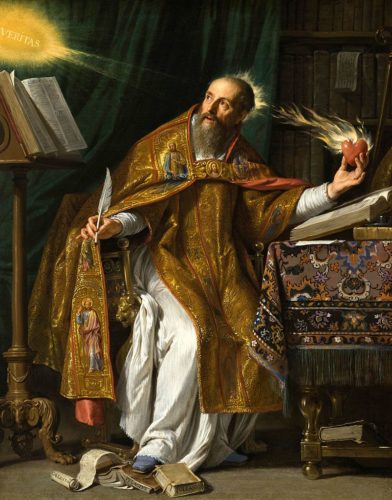
Saint Augustine by Philippe de Champaigne, 1645-50 (Wikipedia)
Most images of Augustine show him in old age as a bishop dressed in splendid vestments. The standard iconography pictures him holding a flaming heart and/or a book. The heart in his hands is not the usual Sacred Heart of Jesus that often appears in Christian icons. Augustine holds his OWN flaming heart. Experts explain that this symbolizes the intensity of his own heart on fire with love of God — or how the heart may burn with “lascivious and harmful loves” until it is given to God.
The conflict between Augustine’s sexuality and spirituality is expressed particularly well in a portrait by French Baroque artist Philippe de Champaigne. In this painting, Augustine looks away from his flaming heart and holds it at arms length like a hot potato, touching it with only his fingertips to avoid getting burned.
In addition to his honored role in the church, Augustine has entered the popular imagination. He even appears on a mug at the DrinklingsCoffeeMugs Etsy shop.with one of his best-known quotes: “The world is a book and those who do not travel read only a page.”
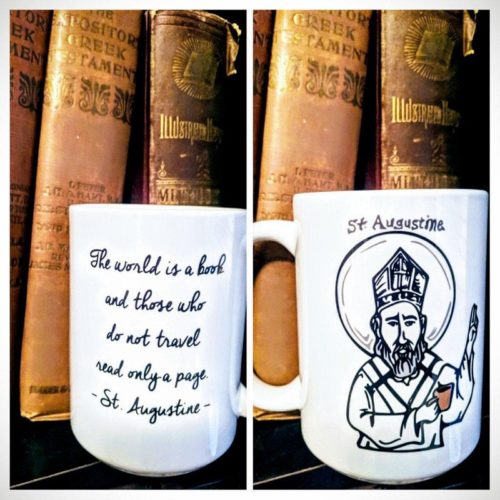
Saint Augustine’s face appears with one of his most famous quotes on mugs available at Etsy.
Other popular quotes by Augustine include:
“You have made us for yourself, O God, and our heart is restless until it rests in you.”
“This very moment I may, if I desire, become the friend of God.”
“There is no saint without a past, no sinner without a future.” (later paraphrased by celebrated gay writer Oscar Wilde)
LGBTQ-Liberation Prayer to Augustine
Canadian gay theologian Donald Boisvert wrote a prayer to Augustine and the Apostle Paul from an LGBTQ-liberation perspective. The prayer is included in his 2004 book “Sanctity and Male Desire: A Gay Reading of Saints.” His chapter on Paul and Augustine draws parallels between the two saints. They are both intellectuals who had dramatic conversion experiences and wrote influential sex-negative theology. Here is his prayer:
Blessed Paul and Augustine, doctors and defenders of the faith, men of integrity, architects of an inhuman theology of sexuality, you have done us harm. We are grateful for the beauty and passion of your words, but we also pray that our common brotherly love will shield us from their poison. You have been misused to condemn us and our desires for the affections and bodies of other men. We think you understood us. We need you now to stand with us. Inspire and motivate the leaders of our faith to see the hatred they spread against us in your name. Convert them as you were once converted. Be our strength, our bold and born-again guides. Amen.
___
To read this article in Spanish, go to:
Agustín de Hipona: el santo que rechazó su pasado bisexual y defendió a las personas intersexuales (Santos Queer)
___
Top image credit:
Detail from “St Jerome and St Augustine” by Carlo Crivelli, c. 1490 (Wikipedia)
___
This post is part of the LGBTQ Saints series by Kittredge Cherry. Traditional and alternative saints, people in the Bible, LGBT and queer martyrs, authors, theologians, religious leaders, artists, deities and other figures of special interest to lesbian, gay, bisexual and transgender and queer (LGBTQ) people and our allies are covered.
This article was originally published in August 2019, was expanded with new material over time, and was most recently updated on June 13, 2025.
Copyright © Kittredge Cherry. All rights reserved.
Qspirit.net presents the Jesus in Love Blog on LGBTQ spirituality.




















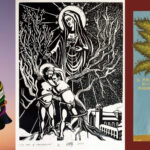

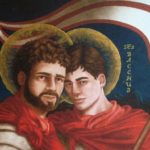
Thank you very much, Kitt, for a great article!
I just feel like adding a few “footnotes.” (1) You wrote, “He was among the first to claim that Sodom was destroyed for the sin of homosexuality.” I believe Augustine read Philo of Alexandria (1st century) who made that claim. Philo saw the sin of Sodom as pederasty. (2) Augustine hailed from “a Romanized family with Berber heritage.” Personally I am not convinced that he had dark skin. On the African continent, dark skin was and is common south of the Sahara desert. Berber skin is more like a soft tan. (3) There may have been some Phoenician blood in his ancestry. The Phoenicians founded Carthage, and the Punic language spoken there was a Phoenician dialect. In one of his works, Augustine mentions “our Punic language.”
Uncultured barbarian that I am, I’ve never read anything by Philo. I’m not positive, but I think pederasty is sodomy with little boys. It wasn’t one of Martin Luther’s 95 theses, but it was something he condemned the Pope for doing. His rhetoric is fiery, but he shows zero sympathy for the boys that he mentions. He clearly only cares about the sodomy part, not the rape part, not the coercion via threat of Hell part, or the underage part. Values were different back then, I guess.
Luther’s claims would be a lot more credible if they were delivered in a less hateful tone. I mean, he says one pope fell over dead for such sins.. that’s unlikely, although maybe it was a heart attack.. I dunno. Pope Leo X probably buggered boys, though. Pederasty was a cherished Roman tradition before their culture and the Christian church merged. There has been a large gay faction within the Church since around 325 .-
That last bit is just my opinion. According to the late Pope Ratliner (?).. Ratzinger, it was the libertine 60s that made the Priests pederasts. That doesn’t explain stuff in the 50s, like how a young Henk Heithuis and his friends got castrated as punishment for going to the cops after being abused by the clergy.Henk died in a car crash 2 years later, after expressing his desire to make a lawsuit for the castration, and on the very same day of the crash, the police came and took all his belongings / court documents and burnt them. That is according to WIkipedia, at least.
ps: Its in Luther’s Works, Volume 47. Page 38. You can find it on archive.org for free.
Can you supply me with the citation of the quote saying that union between a man and a man is better. I am writing a paper and cannot find it.
Augustine wrote, “How much more agreeable for companionship in a life shared together would be two male friends rather than a man and a woman,” in “De Genesi ad litteram” (The Literal Meaning of Genesis) 9.5.9. This link includes more of the quote. Best wishes for your paper!
This article itself admits that Augustine described a friendship with the male acquaintance (does he have a name?), without mentioning sex despite his blunt admission of having sex with umpteen numbers of women, so again this just comes down to “reading between the lines” and then trying to explain why he would admit to fornication with so many women but not admit to sex with a man. And as usual, the word for “love” in the original language often did not mean what it does in modern English (where it now almost entirely means romantic love or sex), so there’s nothing in the actual language to imply romance.
When it comes to non-cis human to human sexuality or behavior, many cultures seem obligated to veil such activity. To this day, the hero must be gilded mythically. This attenuates certain adult themes, but emphasizes others. Despite its authentic nature, even Biblical literature seems to have glints of this.
This is a reply to Sina since the system doesn’t let me reply directly. You’re arguing that Augustine’s culture would require him to obscure any “non-cis” sexual relationships (I think you mean “non-heterosexual” since that’s what we’re talking about here), while other gay activists routinely claim that the culture of the Roman Empire supported homosexual sex. So which is it? In any event, there doesn’t seem to be anything in Augustine’s actual text to imply sex with his male friend, so unless you’re going to claim that every such friend was a romantic sexual partner (which would mean practically everyone would be homosexual) then there’s no basis for making that claim in this case.
This article is a welcome and reassuring arrival for those of us in the LGBTQQI community seeking to reconcile and integrate our sexual natures with our equally powerful and compelling spiritual natures and searches. That Augustine’s journey toward a meaningful and fulfilling relationship with God was also fraught, at times, with questions and perhaps even conflicts around how that endeavor interfaces with his sexuality portrays him as a kindred spirit and fellow human in that regard.
William, your comment shows deep understanding of why it’s important to consider Saint Augustine in an LGBTQ context. Thank you!